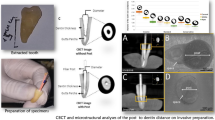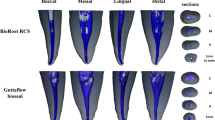Abstract
The aim of this study was to evaluate volumetric and morphological stability of 3 root-end filling materials in addition to porosity and interface voids, using micro-computed tomography (µCT) in high resolution and a highly accurate approach for image analysis. Following root-end resection and apical preparation, two-rooted maxillary premolars were divided into three groups, according to the filling materials: White MTA Angelus, Biodentine, and IRM. Samples were scanned by µCT at 5 µm after the setting time and at time intervals of 7 and 30 days after immersion in phosphate-buffered saline (PBS). Volumetric and morphological changes besides material porosity and interface voids were evaluated by comparing initial values and those obtained after immersion. Data were analyzed statistically, using ANOVA and t-tests (α = 0.05). All materials showed volumetric stability. Regarding the morphological changes, Biodentine had a significant thickness reduction after storage in PBS when compared with MTA. Biodentine also showed an increase in porosity, as well as in percentage and thickness of voids after 30 days of immersion. In conclusion, µCT in high resolution and an accurate image analysis approach may be used to evaluate morphological changes of endodontic materials. Although Biodentine showed suitable adaptability and lower values of porosity than MTA, after PBS immersion there was a dimensional reduction of this material, besides an increase in porosity and interface voids.





Similar content being viewed by others
References
Cavenago BC, Pereira TC, Duarte MA, Ordinola-Zapata R, Marciano MA, Bramante CM, et al. Influence of powder-to-water ratio on radiopacity, setting time, pH, calcium ion release and a micro-CT volumetric solubility of white mineral trioxide aggregate. Int Endod J. 2014;47:120–6.
Williamson AE, Dawson DV, Drake DR, Walton RE, Rivera EM. Effect of root canal filling/sealer systems on apical endotoxin penetration: a coronal leakage evaluation. J Endod. 2005;31:599–604.
Dieter G Elements of the theory of plasticity. In: Dieter G, editors. Mechanical metallurgy; London: McGraw Hill; 1988. pp. 69–102.
Torres FFE, Guerreiro-Tanomaru JM, Bosso-Martelo R, Chavez-Andrade GM, Tanomaru Filho M. Solubility, porosity and fluid uptake of calcium silicate-based cements. J Appl Oral Sci. 2018;26:e20170465.
Sisli SN, Ozbas H. Comparative micro-computed tomographic evaluation of the sealing quality of ProRoot MTA and MTA angelus apical plugs placed with various techniques. J Endod. 2017;43:147–51.
Gandolfi MG, Parrilli AP, Fini M, Prati C, Dummer PM. 3D micro-CT analysis of the interface voids associated with Thermafil root fillings used with AH Plus or a flowable MTA sealer. Int Endod J. 2013;46:253–63.
Cengiz IF, Oliveira JM, Reis RL. Micro-computed tomography characterization of tissue engineering scaffolds: effects of pixel size and rotation step. J Mater Sci Mater Med. 2017;28:129.
Abedi-Amin A, Luzi A, Giovarruscio M, Paolone G, Darvizeh A, Agullo VV, et al. Innovative root-end filling materials based on calcium-silicates and calcium-phosphates. J Mater Sci Mater Med. 2017;28:31.
Perard M, Le Clerc J, Watrin T, Meary F, Perez F, Tricot-Doleux S, et al. Spheroid model study comparing the biocompatibility of biodentine and MTA. J Mater Sci Mater Med. 2013;24:1527–34.
Parirokh M, Torabinejad M, Dummer PMH. Mineral trioxide aggregate and other bioactive endodontic cements: an updated overview - part I: vital pulp therapy. Int Endod J. 2018;51:177–205.
Kebudi Benezra M, Schembri Wismayer P, Camilleri J. Interfacial characteristics and cytocompatibility of hydraulic sealer cements. J Endod. 2018;44:1007–17.
Grech L, Mallia B, Camilleri J. Investigation of the physical properties of tricalcium silicate cement-based root-end filling materials. Dent Mater. 2013;29:e20–8.
Kohli MR, Berenji H, Setzer FC, Lee SM, Karabucak B. Outcome of endodontic surgery: a meta-analysis of the literature-part 3: comparison of endodontic microsurgical techniques with 2 different root-end filling materials. J Endod. 2018;44:923–31.
Maes F, Collignon A, Vandermeulen D, Marchal G, Suetens P. Multimodality image registration by maximization of mutual information. IEEE Trans Med Imaging. 1997;16:187–98.
EzEldeen M, Van Gorp G, Van Dessel J, Vandermeulen D, Jacobs R. 3-dimensional analysis of regenerative endodontic treatment outcome. J Endod. 2015;41:317–24.
Barrett WA, Mortensen EN. Interactive live-wire boundary extraction. MedImage Anal. 1997;1:331–41.
Heckel F, Konrad O, Karl Hahn H, Peitgen H-O. Interactive 3D medical image segmentation with energy-minimizing implicit functions. Computers Graph. 2011;35:275–87.
Quintana RM, Jardine AP, Grechi TR, Grazziotin-Soares R, Ardenghi DM, Scarparo RK, et al. Bone tissue reaction, setting time, solubility, and pH of root repair materials. Clin Oral Investig. 2019;23:1359–66.
Chargo NJ, Robison CI, Akaeze HO, Baker SL, Toscano MJ, Makagon MM, et al. Keel bone differences in laying hens housed in enriched colony cages. Poult Sci. 2019;98:1031–6.
Dawood AE, Manton DJ, Parashos P, Wong R, Palamara J, Stanton DP, et al. The physical properties and ion release of CPP-ACP-modified calcium silicate-based cements. Aust Dent J. 2015;60:434–44.
Singh S, Podar R, Dadu S, Kulkarni G, Purba R. Solubility of a new calcium silicate-based root-end filling material. J Conserv Dent. 2015;18:149–53.
Donnermeyer D, Burklein S, Dammaschke T, Schafer E. Endodontic sealers based on calcium silicates: a systematic review. Odontology. 2019;107:421–36.
Kaup M, Schäfer E, Dammaschke T. An in vitro study of different material properties of biodentine compared to ProRoot MTA. Head Face Med. 2015;11:16.
Biočanin V, Antonijević, Poštić S, Ilić D, Vuković Z, Milić M, et al. Marginal gaps between 2 calcium silicate and glass ionomer cements and apical root dentin. J Endod. 2018;44:816–21.
Ashofteh Yazdi K, Ghabraei S, Bolhari B, Kafili M, Meraji N, Nekoofar MH, et al. Microstructure and chemical analysis of four calcium silicate-based cements in different environmental conditions. Clin Oral Investig. 2019;23:43–52.
Coomaraswamy KS, Lumley PJ, Hofmann MP. Effect of bismuth oxide radioopacifier content on the material properties of an endodontic Portland cement-based (MTA-like) system. J Endod. 2007;33:295–8.
Li X, Yoshihara K, De Munck J, Cokic S, Pongprueksa P, Putzeys E, et al. Modified tricalcium silicate cement formulations with added zirconium oxide. Clin Oral Investig. 2017;21:895–905.
Camilleri J, Grech L, Galea K, Keir D, Fenech M, Formosa L, et al. Porosity and root dentine to material interface assessment of calcium silicate-based root-end filling materials. Clin Oral Investig. 2014;18:1437–46.
Al Fouzan K, Awadh M, Badwelan M, Gamal A, Geevarghese A, Babhair S, et al. Marginal adaptation of mineral trioxide aggregate (MTA) to root dentin surface with orthograde/retrograde application techniques: a microcomputed tomographic analysis. J Conserv Dent. 2015;18:109–13.
Küçükkaya Eren S, Aksel H, Askerbeyli Örs S, Serper A, Koçak Y, Ocak M, et al. Obturation quality of calcium silicate-based cements placed with different techniques in teeth with perforating internal root resorption: a micro-computed tomographic study. Clin Oral Investig. 2019;24:805–11.
Küçükkaya Eren S, Parashos P. Adaptation of mineral trioxide aggregate to dentine walls compared with other root-end filling materials: a systematic review. Aust Endod J. 2019;45:111–21.
Zaslansky P, Fratzl P, Rack A, Wu MK, Wesselink PR, Shemesh H. Identification of root filling interfaces by microscopy and tomography methods. Int Endod J. 2011;44:395–401.
El-Ma’aita AM, Qualtrough AJ, Watts DC. A micro-computed tomography evaluation of mineral trioxide aggregate root canal fillings. J Endod. 2012;38:670–2.
Kim JR, Nosrat A, Fouad AF. Interfacial characteristics of Biodentine and MTA with dentine in simulated body fluid. J Dent. 2015;43:241–7.
Vouzara T, Dimosiari G, Koulaouzidou EA, Economides N. Cytotoxicity of a new calcium silicate endodontic sealer. J Endod. 2018;44:849–52.
Acknowledgements
The study was supported by São Paulo State Research Foundation—FAPESP (grants 2016/00321-0, 2017/22481-1, and 2017/19049-0), Coordenação de Aperfeiçoamento de Pessoal de Nível Superior, Brasil—CAPES (Finance Code 001), National Council for Scientific and Technological Development—CNPq (140215/2015-8 and 308076/2018-4), and Cenpes/Petrobras (ANP2014/00389-8). The authors thank Renato Luiz Carvalho for his assistance with the illustrations.
Author contributions
All authors have contributed significantly and they are all in agreement with the manuscript.
Author information
Authors and Affiliations
Corresponding author
Ethics declarations
Conflict of interest
The authors declare that they have no conflict of interest.
Additional information
Publisher’s note Springer Nature remains neutral with regard to jurisdictional claims in published maps and institutional affiliations.
Rights and permissions
About this article
Cite this article
Torres, F.F.E., Jacobs, R., EzEldeen, M. et al. Micro-computed tomography high resolution evaluation of dimensional and morphological changes of 3 root-end filling materials in simulated physiological conditions. J Mater Sci: Mater Med 31, 14 (2020). https://doi.org/10.1007/s10856-019-6355-2
Received:
Accepted:
Published:
DOI: https://doi.org/10.1007/s10856-019-6355-2




